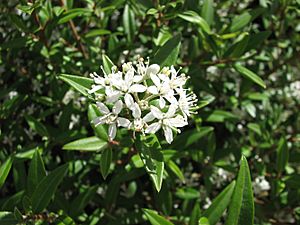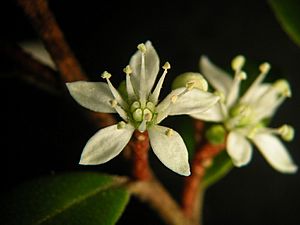Satinwood facts for kids
Quick facts for kids Satinwood |
|
|---|---|
 |
|
| Scientific classification | |
| Kingdom: | |
| (unranked): | |
| (unranked): | |
| (unranked): | |
| Order: | |
| Family: | |
| Genus: |
Nematolepis
|
| Species: |
N. squamea
|
| Binomial name | |
| Nematolepis squamea (Labill.) Paul G. Wilson
|
|
| Synonyms | |
|
|
Nematolepis squamea, often called Satinwood, is a type of upright shrub or small tree. It grows naturally only in Australia. Scientists first officially described this plant in 1805. They first named it Eriostemon squamea.
Later, in 1896, it was moved to the genus Phebalium. Then, in 1998, a scientist named Paul G. Wilson moved it again to the genus Nematolepis. The name Nematolepis squamea has a cool meaning! It comes from Greek and Latin words. 'Nematos' means 'thread', 'lepsis' means 'scale', and 'squameus' means 'scaly'. This name describes the tiny scales found on its leaves, stems, and even its flower parts.
Scientists recognize three main types of this plant, called subspecies:
- N. squamea subsp. coriacea
- N. squamea subsp. retusa
- N. squamea subsp. squamea
Contents
Where Satinwood Grows
Satinwood likes places that are moist and drain water well. You can find it in Tasmania and the southeastern parts of mainland Australia. It often grows in wet sclerophyll forests, rainforests, and near rivers or in gullies. It can live from the coast up to 800 meters high. In drier, colder mountain areas, it usually grows as a shrub.
What Satinwood Looks Like
Nematolepis squamea is an upright shrub or a small tree. It can grow up to 12 meters (about 39 feet) tall. Its leaves are simple and leathery. They are shiny green on top and silvery with tiny scales underneath. The leaves are shaped like a spearhead, usually 2.5 to 8 cm long and up to 2 cm wide. They have a clear central line down the middle.
New stems often have a reddish-brown color and are covered in scales. The leaves have oil glands, so they smell nice when you crush them. The flowers are small and white, about 1 cm across. But they grow in noticeable clusters of up to 20 flowers where the leaves meet the stem. Each flower has five petals and five stamens. Satinwood usually flowers between October and December. After flowering, it produces star-shaped fruit capsules with four or five points.
There's a special type of Satinwood found only in Tasmania, called subspecies retusa. This one always grows as a shrub. It has leaves with rounded tips, shorter leaves, and very scaly, bumpy twigs.
Uses for Satinwood Timber
Satinwood timber is also known as lancewood in the wood industry. It is a very dense and hard wood. It has a beautiful golden and silky look. This timber is great for wood turning, which is shaping wood on a machine. It's also good for making thin sheets called veneer. In the past, it was used to make cabinets.
Growing Satinwood
Satinwood is a strong and reliable plant to grow in gardens. It prefers soil that is moist but drains well. It also likes a spot that gets some shade. This plant can handle a bit of frost. However, it doesn't like long periods of dryness.
Like other plants in the Rutaceae family (which includes citrus fruits), it's easiest to grow new plants from cuttings. You can also trim and prune Satinwood to shape it. This makes it a good choice for a hedge or a screen plant in a garden.
Images for kids
See also
 In Spanish: Nematolepis squamea para niños
In Spanish: Nematolepis squamea para niños



